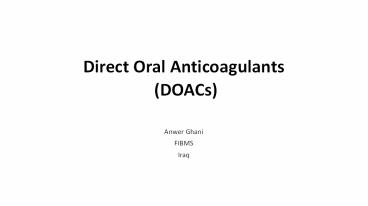Direct oral anticoagulants (DOACs) - PowerPoint PPT Presentation
Title:
Direct oral anticoagulants (DOACs)
Description:
Direct oral anticoagulants (DOACs) – PowerPoint PPT presentation
Number of Views:133
Title: Direct oral anticoagulants (DOACs)
1
.
- Direct Oral Anticoagulants
- (DOACs)
- Anwer Ghani
- FIBMS
- Iraq
2
- Direct oral anticoagulants (DOACs) have quickly
become attractive alternatives to the
long-standing standard of care in
anticoagulation, vitamin K antagonist. - Since the first approval in 2010, DOACs have
emerged as leading therapeutic alternatives that
provide both clinicians and patients with more
effective, safe, and convenient treatment options
in thromboembolic settings.
3
- Direct oral anticoagulants (DOACs)dabigatran
(Pradaxa), rivaroxaban (Xarelto), apixaban
(Eliquis), edoxaban (Savaysa), and betrixaban
(Bevyxxa) are anticoagulation pharmacotherapy
used for the prevention of thrombosis in several
cardiovascular contexts. - DOACs are categorized into 2 main classes oral
direct factor Xa inhibitors (ie, rivaroxaban,
apixaban, edoxaban, and betrixaban) and direct
thrombin inhibitors (ie, dabigatran).
4
- DOACs are relatively new agents demonstrating
superiority or noninferiority to prior standards
of care, anticoagulation with vitamin K
antagonists (VKA ie, warfarin), or
low-molecular-weight heparins (LMWHs), in
reducing risk of thromboembolic complications
with similar or reduced bleeding risk. - Advantages of DOACs compared with VKAs include
fewer monitoring requirements, less frequent
follow-up, more immediate drug onset and offset
effects. - DOAC prescriptions exceeded those for warfarin by
2013, with apixaban being the most frequently
prescribed DOAC for patients with nonvalvular
atrial fibrillation (NVAF).
5
- Dabigatran, rivaroxaban, apixaban, and edoxaban
are approved for the lowering the risk of stroke
and embolism in NVAF as well as deep vein
thrombosis and pulmonary embolism
treatment/prophylaxis.
6
- Unique indications include betrixaban for
prophylaxis of venous thromboembolism (VTE) in
hospitalized patients for an acute medical
illness, and rivaroxaban in combination with
aspirin to reduce major cardiovascular events in
patients with chronic coronary artery disease
(CAD) or peripheral artery disease.
7
AF and PCI
- Dual therapy rivaroxaban (15 mg ) and a P2Y12
inhibitor ( clopidogrel) or - Triple therapy with rivaroxaban 2.5 mg twice
daily plus DAPT - lower bleeding risk in comparison to triple
therapy (VKA at standard AF dosing, aspirin, and
clopidogrel but similar thrombotic events. - Dabigatran (150 mg twice-daily) same.
8
AF and Artificial Heart Valves
- VKA remains the preferred agent for this patient
population . - bioprosthetic acceptable (need study).
9
Atrial Fibrillation With Stable Coronary Disease
- The rivaroxaban monotherapy arm was noninferior
than combination ( DOACAP) in cardiovascular
efficacy measures and superior in reducing major
bleeding. combination
10
Cancer-Associated Thromboembolism
- DOAC are not inferior than LMWH in treatment and
prevention of VTE in cancer patient.
11
CKD
- all are renal excretion.
- Apixoban is the least.
- Dose reduction if agegt65, wtlt60 and scrgt1.5.
12
THANKS
- REFERENCE
- https//www.ahajournals.org/doi/full/10.1161/JAHA.
120.017559































